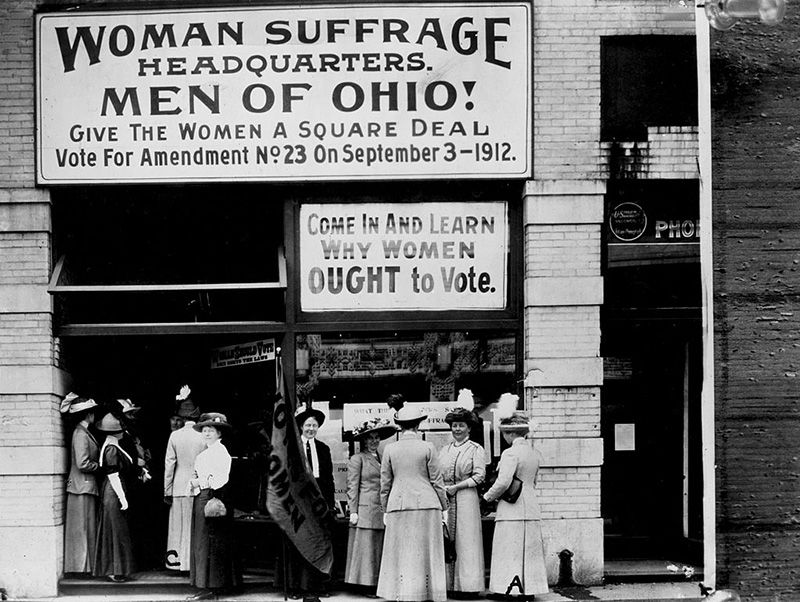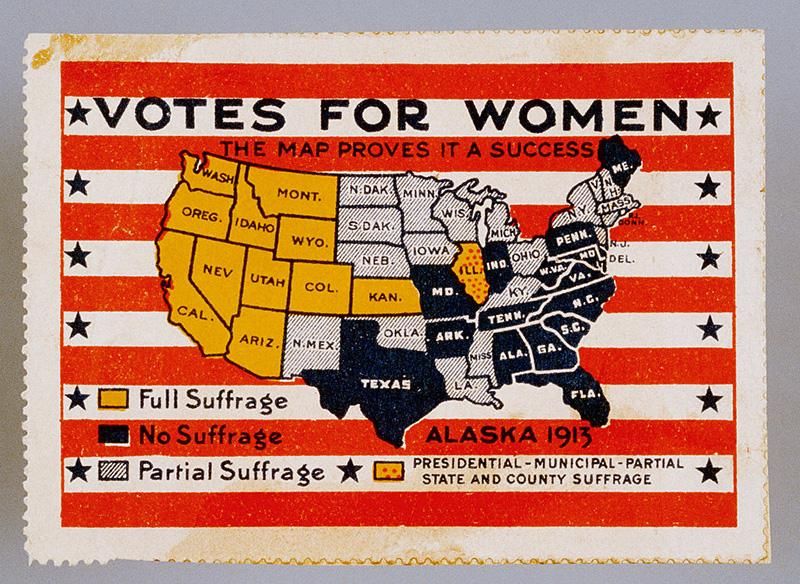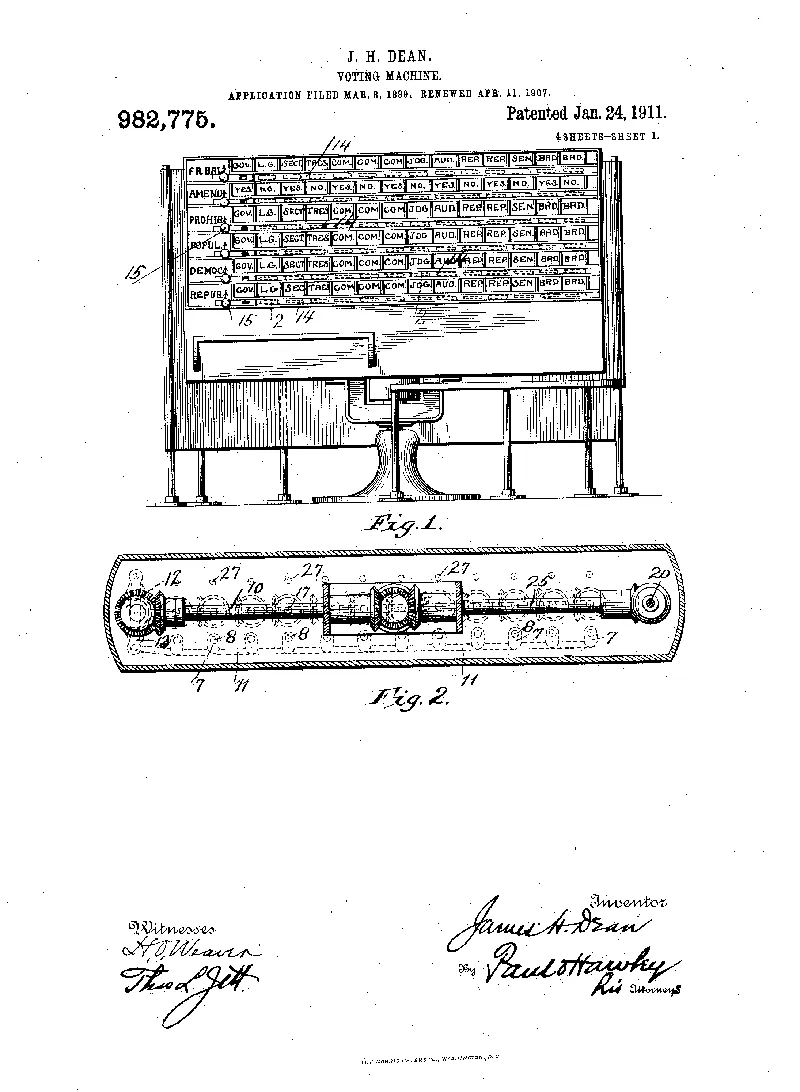The Voting Machine That Displayed Different Ballots Based on Your Sex
In an era of partial suffrage, these inventions helped women cast their votes
/https://tf-cmsv2-smithsonianmag-media.s3.amazonaws.com/filer/bd/e8/bde858a1-1e4b-4b56-b0f8-717792e477fb/voting_machine_patent-main.jpg)
At the turn of the 20th century, half of American adults were restricted from fully participating in the democratic process because of their sex. American women would not be granted the right to vote until 1920, when the 19th Amendment guaranteeing women complete and equal suffrage was ratified and became law. And even that did not rectify the disparity, because many women of color, disenfranchised through various loopholes, had to continue to fight for voting rights.
In May, just before the 100th anniversary of the joint resolution in Congress proposing suffrage for women through the 19th Amendment to the U.S. Constitution, the National Archives Museum in Washington, D.C. opened a new exhibition, “Rightfully Hers: American Women and The Vote.” The show, which runs through January 3, 2021, features photos, documents and interactive displays detailing the struggle to gain the right to vote for all women.
“The 19th Amendment was a landmark achievement that was secured through decades of women’s engagement,” says Corinne Porter, curator of the exhibition. “But that doesn’t mean it was the first time women were voting.”
In fact, women were casting ballots as early as 1838, when Kentucky allowed widows with school-aged children to vote on school issues. Other states would do the same in succeeding years. In 1869, the territory of Wyoming granted women full voting rights in territorial and local elections. Colorado became the first state to pass women’s suffrage into law by popular referendum in 1893. By 1914, 11 states and one territory had given women the right to vote.
While women were rejoicing these small victories, it posed a problem at polling stations. Logistically speaking, how could you allow men to vote unencumbered but restrict women to specific races at the same time?
In 1899, Lenna R. Winslow of Columbus, Ohio, applied for a patent for a “Voting-Machine.” He had created a mechanical system that adjusted the ballot the voter would see based on whether that voter was a man or a woman. With a simple flip of a switch, “the mechanism is automatically set to restrict certain classes of voters by and during their entrance to the booth,” the patent application states.

Voting machines were not new when Winslow came up with his creation. The first voting machine patented in the United States dates to 1875—a simple system with a series of buttons, one per candidate. Winslow’s invention went beyond regular tabulation and tallying, though. His voting machine—essentially an analog computer—recognized if the voter was a man or a woman and allowed them to vote accordingly.
The machine was actually two units: a large voting booth with two doors and the actual hardware for casting ballots and counting votes. The two doors were key to this setup: men used one entrance, marked “Gents,” while women used the other, labeled “Ladies.” A system of levers and switches were activated depending on which door was used, instructing the voting machine on whether full voting or only partial was allowed.
It took nearly a decade for the U.S. Patent Office to rule on Winslow’s application. On August 9, 1910, he received patent number 966,505 for his invention. (The National Archives exhibit includes several of Winslow’s drawings that were part of his patent application.) A number of other inventors also received patents for devices that could differentiate between men and women voters. One machine, patented by Angus Gordon in 1905, locked out all ballots except the one or two needed for female voters when they entered the booth. Another, patented by Charles Abbott in 1914, included a “restricting” bar and lever that prevented the machine from resetting after just one voter. That way, groups of women could vote one after another.
“Lenna Winslow and other individuals saw the opportunity to invent and then patent voting machines that dealt with the issue of women only having partial voting rights,” Porter says. “It is evidence that this condition existed for women and shows how some states may have dealt with that issue on election day.”

The ratification of the 19th Amendment signaled the death knell for restrictive voting machines. With suffrage the law of the land, the efforts of inventors like Lenna Winslow soon became a footnote to history. Their creations were no longer needed and nearly all were consigned to the trash heap. All that remains today are the patent filings and drawings of what those voting machines should look like, with perhaps one exception.
At a small museum in Minneapolis exists what may be the last remaining voting machine used by both men and women of that era. The mechanical unit, patented in 1911, still features the names of candidates from the gubernatorial election of 1914. At that time, Minnesota women could not vote for state or federal candidates, but they could vote in school board elections.

On the back of this voting machine, on display at the Hennepin History Museum, is a sign of those times. In big bold letters, it reads “BEFORE A WOMAN ENTERS THE BOOTH,” then continues with the following instructions:
“1. Place the ‘CLASS VOTE’ lever at letter ‘C’ LEFT HAND
“2. Return it to letter ‘R’ RIGHT HAND as soon as she leaves the booth.”
Like the items on display at the “Rightfully Hers” exhibit at the National Archives Museum, that sign stands as a solemn reminder of the price paid by earlier generations to ensure the rights and freedoms enjoyed by Americans today.
“What I love about our exhibit and these patent drawings is it makes it so clear that there was a lot of activity leading up to the passage of the 19th Amendment,” Porter says. “It’s something I love about our country’s history: it is so much more layered, nuanced and rich than we can appreciate. An anniversary like this is an opportunity to look back at not just the moment we are celebrating but all the moments that led up to it.”
/https://tf-cmsv2-smithsonianmag-media.s3.amazonaws.com/accounts/headshot/dave.png)
/https://tf-cmsv2-smithsonianmag-media.s3.amazonaws.com/accounts/headshot/dave.png)